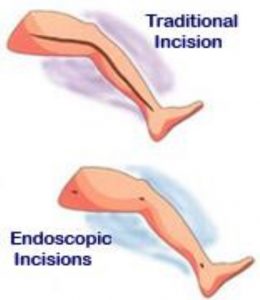Endoscopic Vein Harvesting Explained
 If you have been recommended to undergo Coronary Artery Bypass Surgery (CABG), we can offer you Endoscopic vein harvesting (EVH). Many patients are surprised to learn that a bypass operation may actually include two surgical procedures.
If you have been recommended to undergo Coronary Artery Bypass Surgery (CABG), we can offer you Endoscopic vein harvesting (EVH). Many patients are surprised to learn that a bypass operation may actually include two surgical procedures.
- Primarily, the bypass surgery involves using a healthy blood vessel to “bypass” a damaged or blocked artery in the heart.
- The second procedure is the actual removal of a healthy blood vessel, typically the saphenous vein in the patient’s leg, which will be used to construct the bypass.
What is Endoscopic Vessel Harvesting?
Recent advances in technology have made it possible to perform this second procedure in a new, less invasive way, called Endoscopic Vessel Harvesting, or EVH. Rather than making a large incision in the leg of a patient, surgeons can now make small incisions in the patient’s leg. Because this new procedure results in less muscle and tissue damage when harvesting the vein graft, this procedure may eliminate many of the complications associated with the former technique. This may offer significant benefits to you.
Why you would have EVH?
If you need a CABG, it means that you need your blood flow to be increased in a narrowed or blocked coronary artery. This procedure takes a healthy artery from your leg, chest or arm and attaches it to the blocked coronary artery. Traditionally, when a vein from the leg (saphenous vein) is taken for a CABG procedure, it is taken by making a long cut from the ankle to groin. This can leave a visible scar on your leg. With endoscopic vein harvesting, we make smaller cuts and use minimally invasive equipment to take out the healthy blood vessel. This means that we can limit how much damage there is to the surrounding tissue.
What are the patient benefits from Endoscopic Vessel Harvesting?
This new procedure generally results in less muscle and tissue damage and therefore, may reduce the surgical trauma to the patient, reduced wound infections and decreases the incidence of wound healing complications. In other words:
- you should experience less tissue scarring
- your leg wounds should be less painful
- you should avoid an unsightly scar
- you will be able to concentrate on your cardiac rehabilitation!
In most cases, the small incision approach can be used successfully. However, every surgical patient is unique, and we will recommend the best procedure for you.

